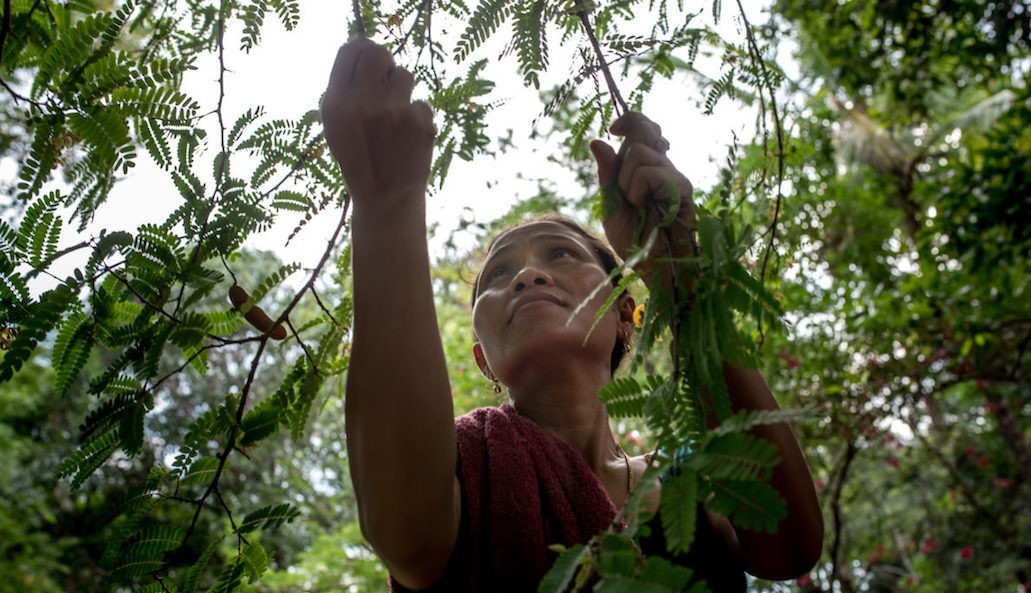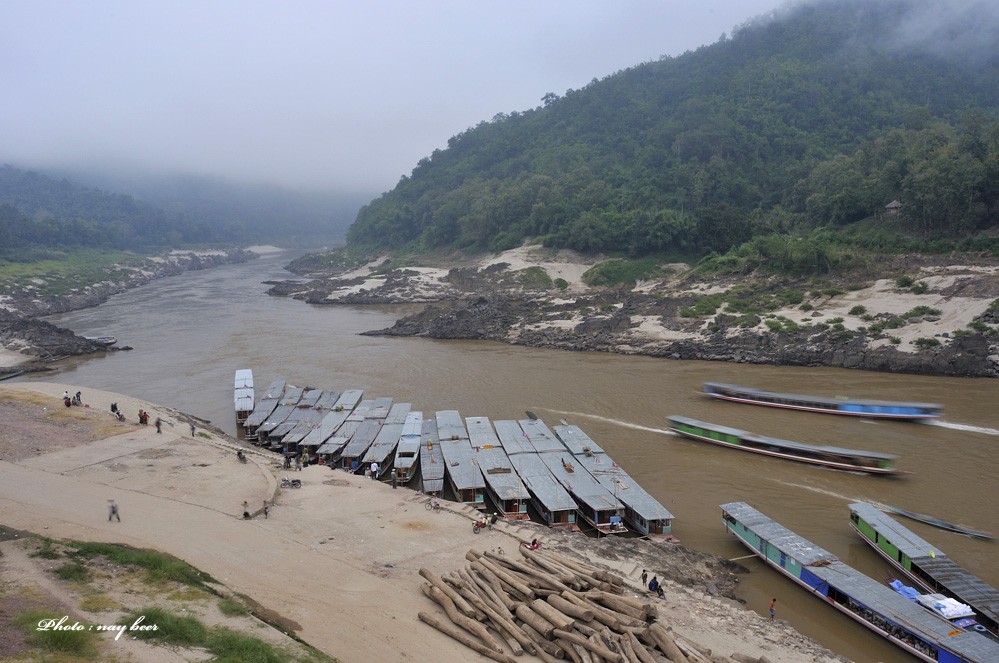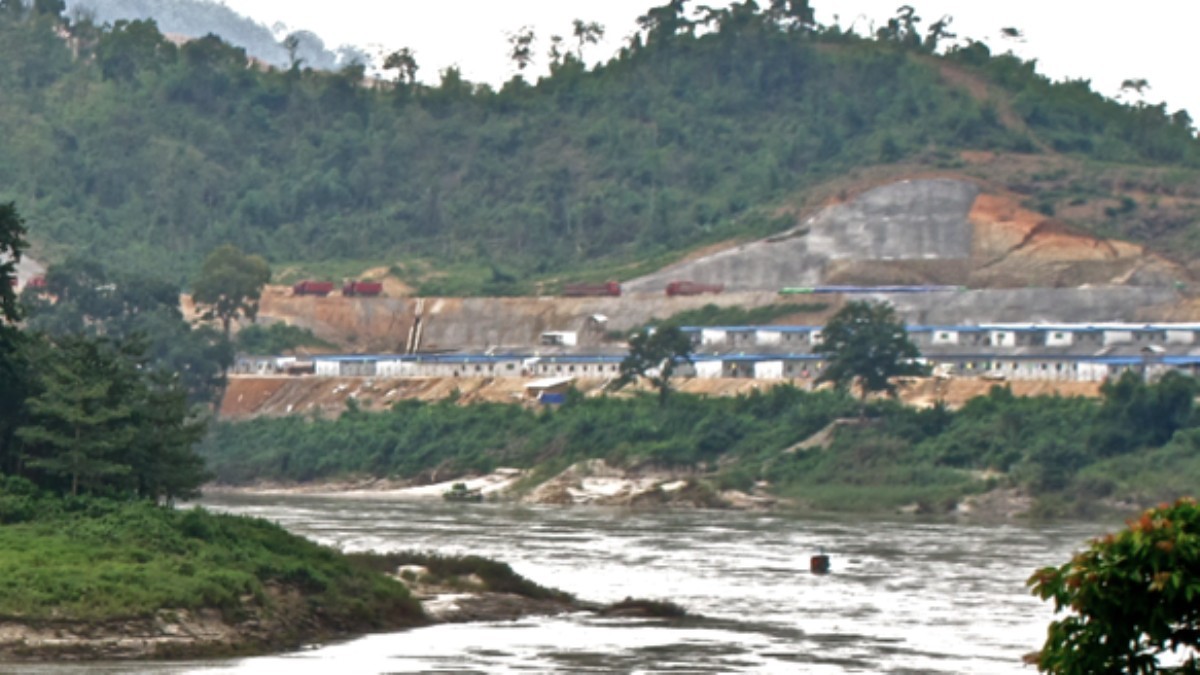At a time when much of Cambodia is developing at a breakneck speed, where smartphones and BMWs have become almost as ubiquitous on the streets of Phnom Penh as saffron-robed monks, the village of Kbal Romeas inhabits a world apart. Tucked deep into the jungles of the country’s untamed northeast, the village has no convenience stores, streetlights, or paved roads. Instead, a visitor would be more likely to find a stretched snakeskin nailed to a piece of teak, drying in the midday sun as a testament to the animist beliefs of the people who live there.
Kbal Romeas and its residents are Cambodian only by the decree of modern geopolitics. They are Bunong, a 2,000-year-old tribe of forest dwellers who have populated the area since long before the concept of the modern Cambodian nation existed. And they are among the people with the most to lose when the Sesan II hydropower dam comes online.
From Steung Treng, the nearest major city and the provincial capital, there are two ways to reach Kbal Romeas. For those with a sturdy enough vehicle, a jarring and potholed dirt road is drivable for parts of the year. The other is by boat, following the Sekong River out of town and then winding southeast along a series of tributaries until the village can be glimpsed between knots of resin trees. All these channels lead back to one place, the river known variously as the Lifeblood of Southeast Asia, the Great River, or The Mother of Water: The Mekong.
As such honorary names imply, the Mekong and its tributaries play an important role in the lives of those who populate its banks, and more than 60 million people directly depend on these waters for their survival. But the Mekong and its offshoots also enjoy the dubious honor of being one of the most increasingly dammed river systems in the world. In its upper stretches, seven mainstream dams have already been built and another 21 are planned, while in the lower basin, 11 separate projects are in the works. Add in small dams and dams on Mekong tributaries, and the number of planned projects exceeds 140.
It is one of these, the Sesan II, that is poised to inundate Kbal Romeas, replacing a culture that has been living in sync with nature since the time of the Romans with an artificial lake six times the size of Manhattan.
“This whole area will be 10 meters underwater,” says Meach Mean, the founder and director of the 3S Rivers Protection Network, a grassroots organization dedicated to opposing the destructive dam building practices in the area. “36,000 hectares (89,000 acres) will disappear during the first rainy season.” Meach has been rallying the roughly 5,000 people from the seven villages set to be inundated, encouraging them to fight the Sesan II since the project was first announced. With powerful backers like The Royal Group of Cambodia (one of the richest investment firms in the Kingdom) and the Chinese state-owned Hydrolancang International Energy Co., it has not been an easy fight. In his view, this is not just a fight to save a river, but cultures as well. “Rivers create a lot of our culture, including our annual boat festivals, the ancient belief in water spirits, Buddhist water blessings, and the national diet,” he said. “If the dam is built it will stop our culture, not just our fish.”
That said, the importance of fish in Cambodia cannot be understated. Most estimates place fish as the primary source of animal protein for somewhere between 60-80 percent of Cambodians. With the rest of the national diet comprised largely of rice and short on mixed vegetables, the loss of fish would lead to more significant nutritional deficits in a country where more than 50 percent of children are underweight. And since nearly one in five Cambodians live on less than $1.25 per day, there are millions who depend on cheap and abundant fish stocks to maintain basic health, unable to regularly afford alternate proteins. Furthermore, fishing accounts for around 12 percent of the national GDP, or roughly the same percentage as the entire manufacturing industry in the United States’ economy.
However, the preservation of Cambodia’s critically important fisheries has increasingly become a secondary goal as the nation develops its electrical infrastructure. An estimated 80 percent of the population lives in the countryside and with one of the fastest growing populations in Asia, the need for poverty reduction programs in these areas is very real. Lacking electricity, many rural Cambodians are unable to start businesses or mechanize their farming processes, permanently indenturing them to a life of subsistence farming. It is in this context that dam projects become so appealing. Touted as a clean way to generate vast amounts of electricity so badly needed across the country, the 400-megawatt output of the Sesan II would in fact be capable of powering tens of thousands of homes that are currently living in the dark.
Yet it is highly unlikely that in the current development climate of Cambodia, where speedy returns on investment are prioritized, that the benefits of the Sesan II will be distributed in such an egalitarian way. Almost 90 percent of the country’s electricity is consumed by the capital, Phnom Penh, and the city still suffers from rolling blackouts on a regular basis. With GDP per capita growing by around 250 percent in the last decade, the demands of wealthy urbanites are likely to continue to skyrocket. In all likelihood, it will not be the rural poor who receive the most benefits from Sesan II’s electrical output, but those in Phnom Penh who can afford to pay for more.
To be an activist in Cambodia is to struggle against one of the most nepotistic and notoriously corrupt governments in Asia. And to be an environmental activist is to resist a political dynasty that has allowed one of the highest deforestation rates in Asia, if not the world. Much of the countryside is choked by clouds of red dust in place of the lush tropical jungles that once stood. Despite these challenges, local-level activists like Meach Mean represent some of the most vocal opponents of the Sesan II, and have been instrumental in drumming up opposition. With little in the way of bureaucratic red tape to hamper his organization, Meach Mean and his disciples are aggressively outspoken against what they perceive to be a great environmental and humanitarian injustice.
“There are three reasons I am against the dam,” 29-year-old Dam Samnang said. One of Kbal Romeas’ most active anti-dam voices and a Bunong himself, Samnang meets with Meach Mean whenever the latter visits the village to trade ideas and talk about recent developments. “It provides no direct benefits to people in this community, it will destroy all our houses, and it will ruin the river system so that we can never come back,” Samnang said. These would be devastating blows to any culture, let alone one that defines its existence based on the ability to live in harmony with nature.
For Samnang, part of the problem is the national ambivalence towards minority tribes such as the Bunong, whose interests are often brushed aside whenever there are large sums of money at stake. While Buddhism and modern technology are slowly percolating into life in Kbal Romeas, the Bunong have little in common with mainstream Cambodian culture. Many residents of the village, particularly the elderly, do not even speak Khmer, the national language.
In Samnang’s mind, this makes them easy to dismiss for policy makers in the capital. “Some Cambodians don’t understand our beliefs,” he explained. “Our ancestors are buried here and if they flood the area we will not be able to come back and visit them. I can’t put a (monetary) value on graves, but if the Prime Minister’s family graves have value, then why don’t ours?”
Not all members of the community share his convictions, and this difference of opinions has deeply divided residents in a way that is immediately apparent to visitors.
Much of Kbal Romeas is built along the main gravel road, with stilted wooden houses in the style typical of such rural communities in Cambodia lining both sides. What makes these houses unusual are the bold passages of Khmer script that have been slashed across nearly every home with spray paint. While there are several variations on wording, there are essentially two core messages that split the villagers along polarized ideological and political lines. The houses marked with red paint have agreed to sell their property to dam developers, while those tagged with blue are refusing to budge. This red-blue divide makes it immediately apparent that though the fate of the physical village might not be yet sealed, the dam’s cultural damage has already been done. Nearly half of the homes sported red paint, and in a community of just 136 families, the loss of half their numbers is a devastating blow.
Samnang is neither surprised nor angry at those who had decided to sell. Rather his frustrations are directed at the dam developers who brought about this division.
Once Samnang and Meach began working together to mobilize the villagers against the dam, Samnang says local authorities, including armed police officers, began periodically arriving in Kabl Romeas. Though they had no legal right to do so, the officers banned all gatherings that related to environmental issues and said that the signing of petitions was not permitted. It is unclear how they would have enforced such a policy, since under Cambodian law the villagers were entitled to do both of these things, but the intimidation strategy no doubt influenced many.
Such fears are firmly rooted in current political realities. Prime Minister Hun Sen’s government has been heavily criticized for an abysmal social justice record. Human Rights Watch describes Cambodia as country where “security forces enjoy impunity for serious human rights abuses, including killings and torture,” and a place where “forced evictions and illegal land acquisitions by politically powerful individuals and their business partners cause social conflict.” As recently as 2014, government troops shot and killed its own protesting citizens. For a remote village standing in the way of powerful business interests and far from the media spotlight, a threat from armed government employees is not something to be taken lightly.
The most favored tactic of Hydrolancang International Energy, however, has been to tempt people away from their ancestral lands with promises of cash and modern houses somewhere else. These resettlement packages are one of the most popular methods employed by land developers throughout the Kingdom. They have been used to successfully displace residents from communities such as Borei Keila and Boeung Kak Lake from their urban neighborhoods to empty fields where there are few job prospects or schools so that their property can be converted into apartment buildings. In every instance, including in Kbal Romeas, this strategy preys on one of the most pervasive problems of Cambodian life — poverty.
According to Meach Mean, widows and the extremely poor were the first to accept the deals on offer, and as company representatives returned with increasingly higher offers, more and more villagers began to accept. “A few years ago everyone rejected the deal,” Meach explained. But as the sums gradually increased, it became harder and harder to hold out: “Poverty forces them to accept eventually.”
Yet there are still many, like Samnang, whose resistance has not bent. His home, tagged with the blue “No Sesan 2” markings that all those opposed sported, was one of the few to employ a third color: in tall green characters, standing out against red lumber reads the message “we will fight until we die, we will not leave.”
Despite his defiance, Samnang has been hard-pressed to overcome his feeling of dread when fighting against the resources of such huge corporations. “I’m worried for my parents and I’m worried for my kids,” Samnang said about his outlook on the future. “This dam will be a disaster for us; our destiny is in trouble. They say they want to develop Cambodia, so why do they destroy our homes?”
Travel expenses for this project were supported by Lien AID, a Singapore-based non-profit focused on providing clean water solutions across Asia. Lien AID did not provide payment to the reporters beyond the hard costs associated with travel, and did not attempt to interfere with the objectivity of the reporting.
Photo credit: Mongabay





